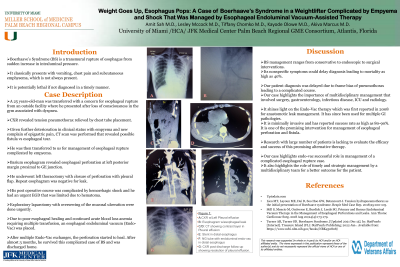Back


Poster Session D - Tuesday Morning
Category: Esophagus
D0242 - Weight Goes Up, Esophagus Pops: A Case of Boerhaave’s Syndrome in a Weightlifter Complicated by Empyema and Shock That Was Managed by Esophageal Endoluminal Vacuum-Assisted Therapy
Tuesday, October 25, 2022
10:00 AM – 12:00 PM ET
Location: Crown Ballroom

Has Audio

Amit Sah, MD
University of Miami/JFK Medical Center
Atlantis, FL
Presenting Author(s)
Amit Sah, MD1, Lesley-Ann G. McCook, MD2, Tiffany Chomko, MD1, Akiva Marcus, MD3, Kayode Olowe, MD3
1University of Miami/JFK Medical Center, Atlantis, FL; 2University of Miami/ JFK Medical Center Palm Beach Regional GME Consortium, Atlantis, FL; 3JFK Medical Center, Atlantis, FL
Introduction: Boerhaave’s Syndrome (BS) is a transmural rupture of esophagus from sudden increase in intraluminal pressure. It classically presents with vomiting, chest pain and subcutaneous emphysema, which is not always present. It is potentially lethal if not diagnosed in a timely manner.
Case Description/Methods: A 25 years-old-man was transferred with a concern for esophageal rupture from an outside facility where he presented after loss of consciousness in the gym associated with dyspnea. CXR revealed tension pneumothorax relieved by chest tube placement. Given further deterioration in clinical status with empyema and new complain of epigastric pain, CT scan was performed that revealed possible fistula vs esophageal tear. He was then transferred to us for management of esophageal rupture complicated by empyema. Barium esophagram revealed esophageal perforation at left posterior margin proximal to GE junction. He underwent left thoracotomy with closure of perforation with pleural flap. Repeat esophagram was negative for leak. His post operative course was complicated by hemorrhagic shock and he had an urgent EGD that was limited due to hematoma. Exploratory laparotomy with oversewing of the mucosal ulceration were done urgently. Due to poor esophageal healing and continued acute blood loss anemia requiring multiple transfusion, an esophageal endoluminal vacuum (Endo-Vac) was placed. After multiple Endo-Vac exchanges, the perforation started to heal. After almost 3 months, he survived this complicated case of BS and was discharged home.
Discussion: BS management ranges from conservative to endoscopic to surgical interventions. Its nonspecific symptoms could delay diagnosis leading to mortality as high as 40%. Our patient diagnosis was delayed due to frame bias of pneumothorax leading to a complicated course. Our case highlights the importance of multidisciplinary management that involved surgery, gastroenterology, infectious disease, ICU and radiology. It shines light on the Endo-Vac therapy which was first reported in 2008 for anastomotic leak management. It has since been used for multiple GI pathologies. It is minimally invasive and has reported success rate as high as 80-90%. It is one of the promising intervention for management of esophageal perforation and fistula. Research with large number of patients is lacking to evaluate the efficacy and success of this promising alternative therapy. Our case highlights its successful role in management of a complicated esophageal rupture case.
Disclosures:
Amit Sah, MD1, Lesley-Ann G. McCook, MD2, Tiffany Chomko, MD1, Akiva Marcus, MD3, Kayode Olowe, MD3. D0242 - Weight Goes Up, Esophagus Pops: A Case of Boerhaave’s Syndrome in a Weightlifter Complicated by Empyema and Shock That Was Managed by Esophageal Endoluminal Vacuum-Assisted Therapy, ACG 2022 Annual Scientific Meeting Abstracts. Charlotte, NC: American College of Gastroenterology.
1University of Miami/JFK Medical Center, Atlantis, FL; 2University of Miami/ JFK Medical Center Palm Beach Regional GME Consortium, Atlantis, FL; 3JFK Medical Center, Atlantis, FL
Introduction: Boerhaave’s Syndrome (BS) is a transmural rupture of esophagus from sudden increase in intraluminal pressure. It classically presents with vomiting, chest pain and subcutaneous emphysema, which is not always present. It is potentially lethal if not diagnosed in a timely manner.
Case Description/Methods: A 25 years-old-man was transferred with a concern for esophageal rupture from an outside facility where he presented after loss of consciousness in the gym associated with dyspnea. CXR revealed tension pneumothorax relieved by chest tube placement. Given further deterioration in clinical status with empyema and new complain of epigastric pain, CT scan was performed that revealed possible fistula vs esophageal tear. He was then transferred to us for management of esophageal rupture complicated by empyema. Barium esophagram revealed esophageal perforation at left posterior margin proximal to GE junction. He underwent left thoracotomy with closure of perforation with pleural flap. Repeat esophagram was negative for leak. His post operative course was complicated by hemorrhagic shock and he had an urgent EGD that was limited due to hematoma. Exploratory laparotomy with oversewing of the mucosal ulceration were done urgently. Due to poor esophageal healing and continued acute blood loss anemia requiring multiple transfusion, an esophageal endoluminal vacuum (Endo-Vac) was placed. After multiple Endo-Vac exchanges, the perforation started to heal. After almost 3 months, he survived this complicated case of BS and was discharged home.
Discussion: BS management ranges from conservative to endoscopic to surgical interventions. Its nonspecific symptoms could delay diagnosis leading to mortality as high as 40%. Our patient diagnosis was delayed due to frame bias of pneumothorax leading to a complicated course. Our case highlights the importance of multidisciplinary management that involved surgery, gastroenterology, infectious disease, ICU and radiology. It shines light on the Endo-Vac therapy which was first reported in 2008 for anastomotic leak management. It has since been used for multiple GI pathologies. It is minimally invasive and has reported success rate as high as 80-90%. It is one of the promising intervention for management of esophageal perforation and fistula. Research with large number of patients is lacking to evaluate the efficacy and success of this promising alternative therapy. Our case highlights its successful role in management of a complicated esophageal rupture case.
Disclosures:
Amit Sah indicated no relevant financial relationships.
Lesley-Ann McCook indicated no relevant financial relationships.
Tiffany Chomko indicated no relevant financial relationships.
Akiva Marcus indicated no relevant financial relationships.
Kayode Olowe indicated no relevant financial relationships.
Amit Sah, MD1, Lesley-Ann G. McCook, MD2, Tiffany Chomko, MD1, Akiva Marcus, MD3, Kayode Olowe, MD3. D0242 - Weight Goes Up, Esophagus Pops: A Case of Boerhaave’s Syndrome in a Weightlifter Complicated by Empyema and Shock That Was Managed by Esophageal Endoluminal Vacuum-Assisted Therapy, ACG 2022 Annual Scientific Meeting Abstracts. Charlotte, NC: American College of Gastroenterology.
